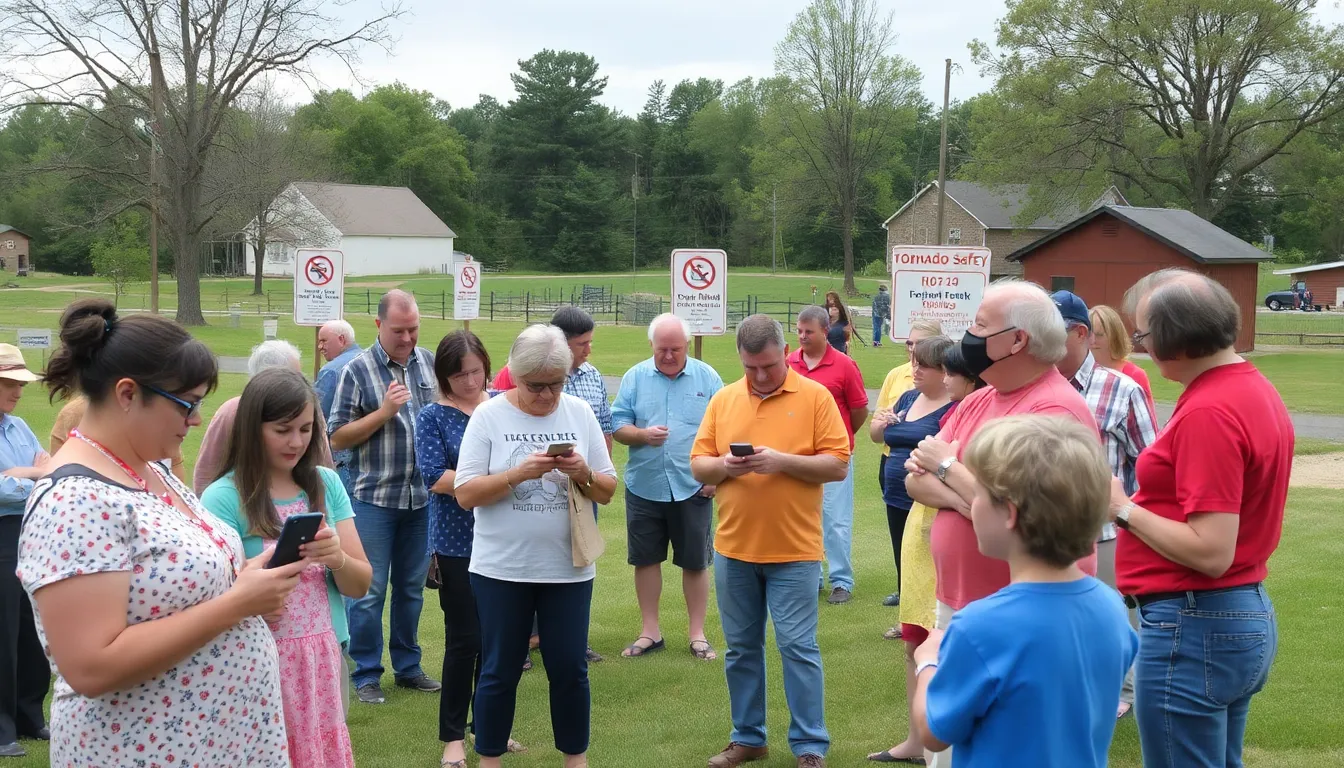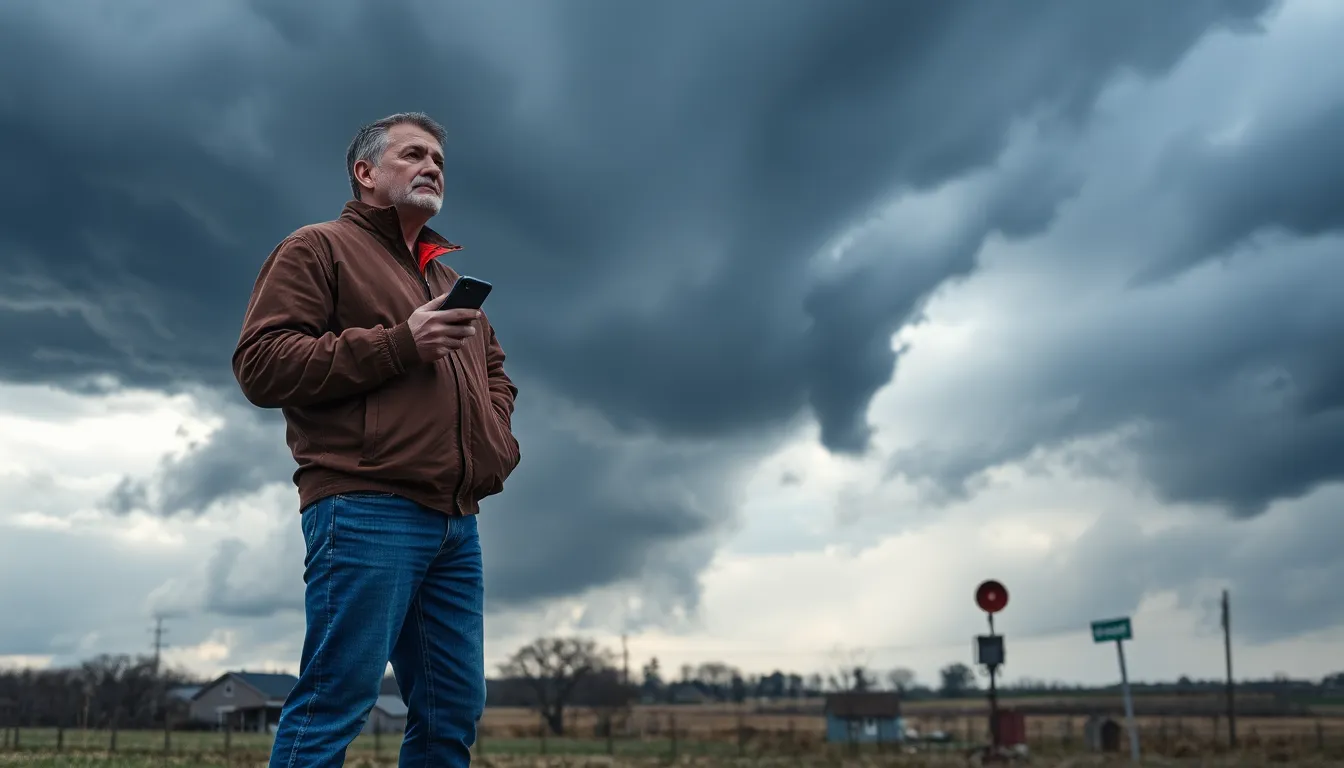Tornado warnings can strike fear into the hearts of residents, and Clinton County, Ohio, is no exception. Nestled in the heart of the Midwest, this area faces its share of severe weather, particularly during storm season. Understanding tornado warnings and their implications is crucial for keeping families safe and prepared.
When a tornado warning is issued, it signals imminent danger. Local authorities and meteorologists work tirelessly to monitor conditions and provide timely alerts. For Clinton County residents, knowing how to respond can make all the difference. From seeking shelter to staying informed, being proactive can save lives during these unpredictable weather events.
Table of Contents
ToggleOverview of Clinton County Tornado Warnings
Clinton County, Ohio, experiences tornado warnings that significantly impact local residents. Tornado warnings occur when meteorologists identify a funnel cloud or rotating circulation on radar, indicating imminent danger. Residents in Clinton County should pay attention to these warnings, especially during peak tornado season, which typically stretches from April to June.
Local authorities rely on the National Weather Service (NWS) for information regarding severe weather conditions. The NWS issues advisories, watches, and warnings based on real-time data. This communication system ensures that residents receive timely alerts. Community members can receive alerts through various channels, including NOAA Weather Radio and local news outlets.
Residents are encouraged to develop emergency plans. Preparedness includes designating safe spaces within homes for sheltering, such as basements or interior rooms. It’s vital to keep emergency supplies accessible, including flashlights, batteries, and first aid kits. Staying informed about weather conditions can also enhance safety, particularly by monitoring updates during severe weather events.
Clinton County authorities often conduct drills and public education campaigns focused on tornado safety measures. Participation in these initiatives can increase community resilience against tornado threats. By understanding warnings, residents can act swiftly to protect themselves and their families during severe weather events.
Historical Context

Clinton County, Ohio, has a history marked by significant tornado activity, impacting its communities and shaping local preparedness measures. Understanding this history is crucial for residents to enhance their response to tornado warnings.
Notable Tornado Events
Clinton County experienced several notable tornado events that have defined its storm history.
- 1974 Super Outbreak: This massive severe weather event produced multiple tornadoes across Ohio, including in Clinton County, causing extensive damage and altering how tornadoes were perceived in the region.
- 2011 Tornado: An EF1 tornado struck around the small community of Sabina, damaging structures and bringing attention to the importance of timely tornado alerts.
- 2019 Tornado: This tornado also impacted areas in and around Clinton County, prompting swift community responses and reflecting improved warning systems and public awareness efforts.
Timeline of Tornado Warnings
A timeline of tornado warnings highlights the advancements in alert systems and community preparation tactics.
- 1993: The NWS implemented advanced Doppler radar technology, revolutionizing the prediction and monitoring of tornado activity in Clinton County.
- 2007: A significant tornado warning was issued for Clinton County, which led to increased public engagement in safety drills.
- 2015: The introduction of mobile alert systems allowed residents to receive immediate notifications about tornado warnings via text messages.
- 2021: Continued education programs focused on tornado preparedness were introduced, reflecting the county’s ongoing commitment to improving community resilience.
Tracking these warnings and events underscores the vital role of local authorities and meteorologists in protecting residents during severe weather conditions.
Current Warning Systems
Clinton County relies on robust warning systems to alert residents about impending tornado threats. These systems are crucial for ensuring public safety during severe weather events.
Role of the National Weather Service
The National Weather Service (NWS) plays a vital role in monitoring severe weather conditions and issuing tornado warnings for Clinton County. NWS employs advanced technology, including Doppler radar, to detect storm patterns and wind rotations indicative of tornado formation. When conditions warrant, the NWS issues alerts through multiple channels, including television broadcasts, radio notifications, and mobile alerts. These warnings are designed to reach residents quickly, providing real-time updates and information essential for public safety. Observers, including trained meteorologists, continuously analyze data to refine forecasts and enhance warning accuracy.
Local Emergency Management Procedures
Local emergency management procedures in Clinton County are structured to complement NWS alerts. Coordinated by county officials, these procedures involve several key steps to ensure community preparedness. Emergency management personnel regularly conduct drills to educate residents about tornado safety protocols. They also distribute informational materials that outline safe shelter locations and emergency supply lists. Upon receiving a tornado warning from the NWS, local authorities implement community response plans, including activating sirens and deploying emergency response teams. Their proactive approach aims to minimize risks associated with tornadoes and improve the community’s overall resilience against severe weather events.
Community Preparedness
Community preparedness for tornado events in Clinton County is crucial for ensuring safety and resilience. By utilizing available resources and adhering to safety protocols, residents can enhance their response to tornado warnings.
Resources Available to Residents
Residents of Clinton County can access numerous resources to bolster their preparedness.
- National Weather Service (NWS): The NWS provides real-time weather alerts and updates, including tornado warnings, through various platforms such as websites, mobile apps, and social media.
- Local Emergency Management Agency (LEMA): LEMA offers community-specific information on tornado safety and preparedness plans, along with instructions for residents during severe weather events.
- Community Alert Systems: Residents can enroll in community alert systems for instant notifications regarding weather threats, allowing them to stay informed about tornado warnings and advisories.
- Emergency Preparedness Kits: Organizations like the American Red Cross provide guidelines for assembling emergency kits. These kits should include non-perishable food, water, medical supplies, and a flashlight.
- Educational Programs: Local libraries and community centers frequently host workshops and seminars focused on tornado preparedness, equipping residents with knowledge and skills to respond effectively.
Safety Tips During Tornado Warnings
Following safe practices during tornado warnings enhances individual and community safety.
- Seek Shelter Immediately: Residents should locate a safe space, such as a basement or interior room on the lowest floor, away from windows.
- Stay Informed: Regularly monitor updates from the NWS through radio, mobile apps, or TV to receive the latest information on impending storms.
- Avoid Vehicles: Residents should not attempt to outrun tornadoes in vehicles. Instead, they should find sturdy shelter or lie flat in a low-lying area if no shelter is available.
- Prepare for Power Outages: Keep flashlights, batteries, and a battery-operated radio ready, as power outages may occur during severe weather.
- Practice Drills: Communities should organize tornado drills to familiarize residents with safety protocols, ensuring preparedness when an actual warning occurs.
Recent Tornado Warning Analysis
Recent tornado warnings in Clinton County, Ohio, showcase the area’s ongoing vulnerability to severe weather. Analyzing specific incidents and their impacts can shed light on community preparedness and response.
Specific Incidents in Clinton County
Notable tornado incidents highlight Clinton County’s severe weather history. The 1974 Super Outbreak resulted in significant damage, prompting improved response protocols. The EF1 tornado in Sabina in 2011, with wind speeds up to 110 mph, led to property destruction but no fatalities, demonstrating community resilience. In 2019, another tornado touched down, confirming the region’s persistent risk and the necessity of updated warning systems. Continuous advancements in technology contribute to more effective forecasting and prompt alerts, allowing residents to respond swiftly during emergencies.
Impact on the Community
Tornado warnings have profound impacts on the Clinton County community. Each warning enhances awareness of severe weather threats and emphasizes the need for preparedness. Community engagement through drills and educational programs fosters a culture of readiness. Local organizations distribute vital information about safety measures and emergency planning, equipping residents to respond effectively. The collaboration between local authorities and the National Weather Service ensures residents receive timely alerts, ultimately reducing loss of life and property during severe weather events. Effective communication channels, including sirens and mobile notifications, further strengthen community resilience against tornado threats.
Staying informed and prepared is essential for residents of Clinton County when facing tornado threats. The combination of timely warnings and community engagement significantly enhances safety and resilience. By understanding the local history of tornado activity and the advancements in alert systems, individuals can better respond to emergencies.
Developing a robust emergency plan and participating in community drills fosters a culture of readiness. As tornado season approaches, remaining vigilant and proactive can make all the difference in protecting lives and property. The commitment to preparedness not only empowers individuals but also strengthens the entire community against severe weather events.




